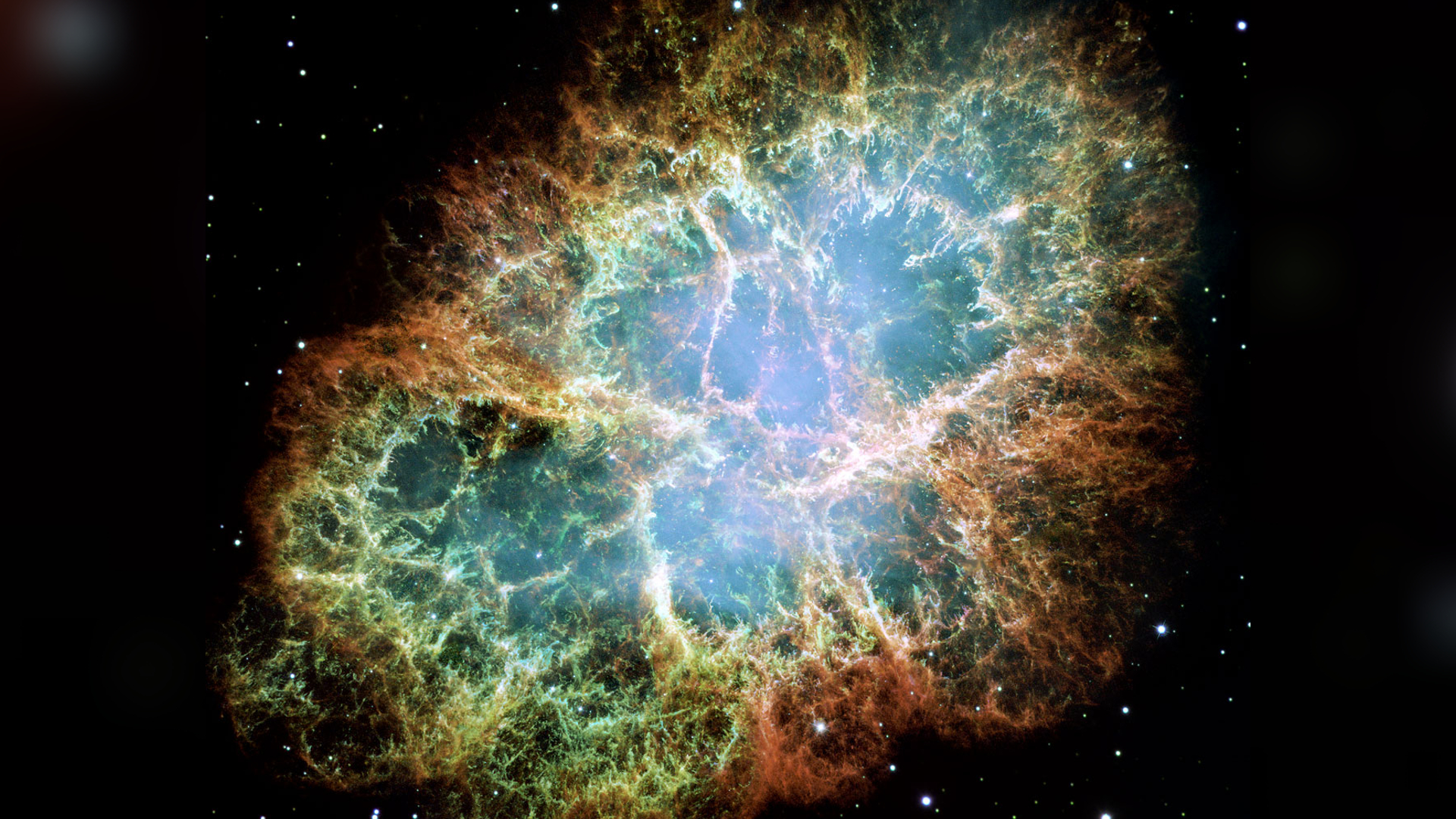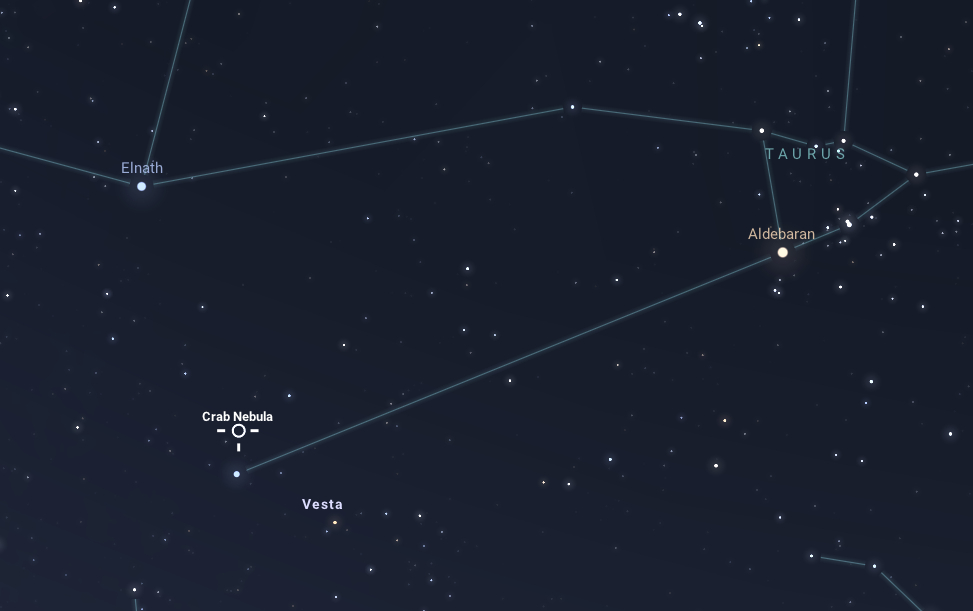Crab Nebula: Everything you need to know
The Crab Nebula is one of the brightest supernova remnants in the night sky.

The Crab Nebula, also known as Messier 1 (M1), is one of the brightest supernova remnants in the sky.
As the name supernova remnant suggests, it's the leftovers from a star's explosive death. When a massive star runs out of fuel, the outer layers lose their support from the heat and pressure in the star's core. They crash down towards the center of the star and then rebound in a huge explosion — what we call a supernova.
What we see now as the Crab Nebula is all the gas — mostly hydrogen — spewed out from inside that dying star.
You might wonder why we call it both a nebula and a supernova remnant — a supernova remnant is essentially a type of nebula, and a nebula is a broader bucket category for patches of gas and dust shining in the sky.
Related: The brightest planets in the night sky: How to see them (and when)
What's in the Crab Nebula?
The Crab Nebula is mostly gas. But, a curious object lurks at the center: the leftover core from the dead star, known as a pulsar. Pulsars are a particular kind of dense neutron star with a powerful magnetic field. Spinning extremely fast — anywhere from a few to a hundred times per second — their jets of matter spew out and sweep over Earth like a lighthouse, producing the pulses we observe that give these zombie stars their name. The pulsar in the Crab Nebula spins 30 times per second and produces the glow seen in the center of images of the nebula.
How big is the Crab Nebula?
The Crab Nebula is about 10 light-years across, the equivalent of about 10 trillion miles, and it's still growing, according to NASA. The gas of the Crab Nebula is expanding through space at over 600 miles per second.
When did it explode, and when was it discovered?
The star that created the Crab Nebula exploded in 1054 when it was recorded as a "guest star" in the sky by Chinese astronomers. Even non-astronomers probably noticed its appearance, since the supernova explosion was so bright it was comparable to the full moon, six times brighter than Venus. It was bright enough to be seen during the day for an entire month. Some historians believed that Native Americans recorded this event in cave paintings as well, but that theory was recently debunked.
European astronomers didn't notice the fainter nebula until hundreds of years after the initial explosion when English astronomer John Bevis observed it through a telescope in 1731. Charles Messier added the Crab as the first entry in his famous Messier Catalog soon after in 1758, and Lord Rosse gave the nebula its crustacean-inspired name in 1844 because its filaments reminded him of crab legs.
Where is it located, and how far away is it from Earth?

Right Ascension: 05h 34m 32s
Declination: +22° 00’ 52”
The Crab Nebula is visible to those in both the Northern and Southern Hemisphere the constellation Taurus at some point in the year. For those in the Northern Hemisphere, the best time to observe it is January, and for the Southern Hemisphere, you can get a glimpse in the summer months. You can see it with binoculars, but for the best viewing experience, you'll want a small telescope. Although it's so bright (around 8th magnitude), the Crab Nebula is 6,500 light years from Earth.
Crab Nebula FAQs answered by an expert
We asked Rebecca Lin, astronomy graduate student at the University of Toronto, a few frequently asked questions about the Crab Nebula.
Rebecca Lin is a PhD candidate at the University of Toronto. Her research focuses on using very long baseline interferometry (VLBI) to study the Crab Pulsar, the neutron star at the heart of the Crab Nebula. VLBI is a technique where astronomers use several radio telescopes across the world to achieve a high resolution, as if they had a massive radio telescope the size of the Earth. In her latest work, she uses this to precisely measure the distance to the Crab Pulsar, which was not well known until now.
What is special about the Crab Nebula?
It is one of the brightest radio sources in the sky, and at the heart of it is a very bright and energetic pulsar. The pulsar is observed across the entire light spectrum, from radio waves to gamma rays. The pulsar generates a very powerful wind that interacts with the expanding nebula and generates very intricate and beautiful filaments, which can be seen in images from the Hubble Space Telescope.
Why did the Crab Nebula explode?
The Crab Nebula is the result of a supernova that occurred in 1054 AD, historically recorded by Chinese astronomers.
Additional resources
Learn more about the pulsar at the heart of the Crab, or about another famous nebula: The Eagle (M16). SPACE.com has also collected lists of 50 fabulous nebula photos and great images of supernova explosions for you to peruse.
Bibliography
NASA. Messier 1: The Crab Nebula. Retrieved August 15, 2023 from https://www.nasa.gov/feature/goddard/2017/messier-1-the-crab-nebula
NASA. The Spinning Pulsar of the Crab Nebula. Retrieved August 15, 2023 from https://science.nasa.gov/spinning-pulsar-crab-nebula
Astronomy Picture of the Day. M1: The Expanding Crab Nebula. Retrieved August 15, 2023 from https://apod.nasa.gov/apod/ap230320.html
The Sky Live. Messier 1 (The Crab Nebula) - Supernova Remnant in Taurus. Retrieved August 15, 2023 from https://theskylive.com/sky/deepsky/messier-1-the-crab-nebula-object
Kopernik Observatory and Science Center. A History of the Crab Nebula. Retrieved August 15, 2023 from http://www.kopernik.org/images/archive/crab.htm
Scientific American. Supernova Cave Art Myth Debunked. Retrieved August 15, 2023 from https://blogs.scientificamerican.com/observations/e28098supernovae28099-cave-art-myth-debunked/
Join our Space Forums to keep talking space on the latest missions, night sky and more! And if you have a news tip, correction or comment, let us know at: community@space.com.
Get the Space.com Newsletter
Breaking space news, the latest updates on rocket launches, skywatching events and more!

Briley Lewis (she/her) is a freelance science writer and Ph.D. Candidate/NSF Fellow at the University of California, Los Angeles studying Astronomy & Astrophysics. Follow her on Twitter @briles_34 or visit her website www.briley-lewis.com.










